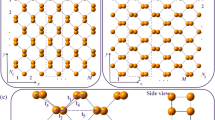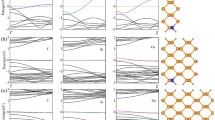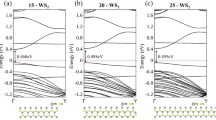Abstract
Electronic structures and transport in armchair PtS2 nanoribbons are studied based on the density functional theory. Bare nanoribbons are magnetic metal with strong negative differential resistance (NDR). In an environment of low hydrogen concentration, the nanoribbons convert to the magnetic semiconductor. The conductance becomes negligible under a bias below 1 V due to the mismatch of wave functions between edge and bulk states. However, a transition from magnetic semiconductor to nonmagnetic metal can occur if a strain of 7% is applied. The stretched nanoribbons then become conductive again with an even stronger NDR. The hydrogen concentration can be used to further modulate the energy gap, the edge magnetism, and conductivity by varying the adsorbed H atoms on the edge. Our study highlights the potential of armchair PtS2 nanoribbons for spintronic nanodevices controlled by both strain and hydrogenation.






Similar content being viewed by others
References
Brandbyge M, Mozos J-L, Ordejón P, Taylor J, Stokbro K (2002) Density-functional method for nonequilibrium electron transport. Phys Rev B 65:165401
Cao M-S, Shu J-C, Wang X-X, Wang X, Zhang M, Yang H-J, Fang X-Y, Yuan J (2019) Electronic structure and electromagnetic properties for 2D electromagnetic functional materials in gigahertz frequency. Ann Phys 531:1800390
Chen C, Wang X-F, Li Y-S, Cheng X-M, Yao A-L (2017) Single-band negative differential resistance in metallic armchair MoS2 nanoribbons. J Phys D Appl Phys 50:465302
Correa JH, Pezo A, Figueira MS (2018) Braiding of edge states in narrow zigzag graphene nanoribbons: effects of third-neighbor hopping on transport and magnetic properties. Phys Rev B 98:045419
Datta S (2004) Quantum transport: atom to transistor Purdue University. Cambridge University Press, Cambridge
Deng S, Zhang Y, Li L (2019) Study on electronic and optical properties of the twisted and strained MoS2/PtS2 heterogeneous interface. Appl Surf Sci 476:308–316
Du J, Song P, Fang L, Wang T, Wei Z, Li J, Xia C (2018) Elastic, electronic and optical properties of the two-dimensional PtX2 (X = S, Se, and Te) monolayer. Appl Surf Sci 435:476–482
Fernández-Rossier J, Jacob D, Untiedt C, Palacios JJ (2005) Transport in magnetically ordered Pt nanocontacts. Phys Rev B 72:224418
Hoa ND, Van Quy N, Jung H, Kim D, Kim H, Hong S-K (2010) Synthesis of porous CuO nanowires and its application to hydrogen detection. Sens Actuators B 146:266–272
Hou S, Han L, Wu L, Quhe R, Lu P (2017) Robust quasi-ohmic contact against angle rotation in noble transition-metal-dichalcogenide/graphene heterobilayers. RSC Adv 7:45896–45901
Huang H, Ong CY, Guo J, White T, Tse MS, Tan OK (2010) Pt surface modification of SnO2 nanorod arrays for CO and H2 sensors. Nanoscale 2:1203–1207
Huang Y, Ling C, Liu H, Wang S (2014) Tuning electronic and magnetic properties of SnSe2 armchair nanoribbons via edge hydrogenation. J Mater Chem C 2:10175–10183
Kaasbjerg K, Thygesen KS, Jacobsen KW (2012) Phonon-limited mobility in n-type single-layer MoS2 from first principles. Phys Rev B 85:115317
Kjekshus A, Grønvold F (1959) High temperature X-ray study of the thermal expansion of PtS2, PtSe2, PtTe2 and PdTe2. Acta Chem Scand 13:1767–1774
Larsen AH, Mortensen JJ, Blomqvist J, Castelli IE, Christensen R, Dulak M, Friis J, Groves MN, Hammer B, Hargus C, Hermes ED, Jennings PC, Bjerre Jensen P, Kermode J, Kitchin JR, Kolsbjerg EL, Kubal J, Kaasbjerg K, Lysgaard S, Maronsson JB, Maxson T, Olsen T, Pastewka L, Peterson A, Rostgaard C, Schiotz J, Schutt O, Strange M, Thygesen KS, Vegge T, Vilhelmsen L, Walter M, Zeng Z, Jacobsen KW (2017) The atomic simulation environment—a Python library for working with atoms. J Phys Condens Matter 29:273002
Liu S, Liu Z (2018) Hybridization induced metallic and magnetic edge states in noble transition-metal-dichalcogenides of PtX2 (X = S, Se) nanoribbons. Phys Chem Chem Phys 20:21441–21446
Liu G, Gan Y, Quhe R, Lu P (2018) Strain dependent electronic and optical properties of PtS2 monolayer. Chem Phys Lett 709:65–70
Liu J, Xu H, Yan J, Huang J, Song Y, Deng J, Wu J, Ding C, Wu X, Yuan S, Li H (2019) Efficient photocatalytic hydrogen evolution mediated by defect-rich 1T-PtS2 atomic layer nanosheet modified mesoporous graphitic carbon nitride. J Mater Chem A 7:18906–18914
Maloney FS, Wang W (2016) Influence of the Sn oxidation state in ferromagnetic Sn-doped In2O3 nanowires. Appl Phys Lett 109:243104
Ma’Mari FA, Moorsom T, Teobaldi G, Deacon W, Prokscha T, Luetkens H, Lee S, Sterbinsky GE, Arena DA, MacLaren DA, Flokstra M, Ali M, Wheeler MC, Burnell G, Hickey BJ, Cespedes O (2015) Beating the Stoner criterion using molecular interfaces. Nature 524:69–73
Manchanda P, Enders A, Sellmyer DJ, Skomski R (2016) Hydrogen-induced ferromagnetism in two-dimensional Pt dichalcogenides. Phys Rev B 94:104426
Oles AM, Stollhoff G (1984) Correlation effects in ferromagnetism of transition metals. Phys Rev B 29:314–327
Ouyang F, Yang Z, Ni X, Wu N, Chen Y, Xiong X (2014) Hydrogenation-induced edge magnetization in armchair MoS2 nanoribbon and electric field effects. Appl Phys Lett 104:071901
Owens FJ (2008) Electronic and magnetic properties of armchair and zigzag graphene nanoribbons. J Chem Phys 128:194701
Pang J, Mendes RG, Bachmatiuk A, Zhao L, Ta HQ, Gemming T, Liu H, Liu Z, Rummeli MH (2019) Applications of 2D MXenes in energy conversion and storage systems. Chem Soc Rev 48:72–133
Peng Q, Li J, He C, Tang C, Zhong J (2018) First-principles study of magnetic properties of ultra-thin MoSi2 films. J Appl Phys 123:104304
Pi L, Li L, Hu X, Zhou S, Li H, Zhai T (2018) Temperature dependence of Raman responses of few-layer PtS2. Nanotechnology 29:505709
Pi L, Li L, Liu K, Zhang Q, Li H, Zhai T (2019) Recent progress on 2D noble-transition-metal dichalcogenides. Adv Funct Mater 29:1904932
Shi H, Pan H, Zhang Y-W, Yakobson BI (2013) Strong ferromagnetism in hydrogenated monolayer MoS2 tuned by strain. Phys Rev B 88:205305
Vedala H, Sorescu DC, Kotchey GP, Star A (2011) Chemical sensitivity of graphene edges decorated with metal nanoparticles. Nano Lett 11:2342–2347
Wang Y, Li L, Yao W, Song S, Sun JT, Pan J, Ren X, Li C, Okunishi E, Wang Y-Q, Wang E, Shao Y, Zhang YY, Yang H-T, Schwier EF, Iwasawa H, Shimada K, Taniguchi M, Cheng Z, Zhou S, Du S, Pennycook SJ, Pantelides ST, Gao HJ (2015) Monolayer PtSe2, a new semiconducting transition-metal-dichalcogenide, epitaxially grown by direct selenization of Pt. Nano Lett 15:4013–4018
Wang S, Robertson A, Warner JH (2018) Atomic structure of defects and dopants in 2D layered transition metal dichalcogenides. Chem Soc Rev 47:6764–6794
Xu B, Yin J, Xia YD, Wan XG, Jiang K, Liu ZG (2010) Electronic and magnetic properties of zigzag graphene nanoribbon with one edge saturated. Appl Phys Lett 96:163102
Xu H, Huang H-P, Fei H, Feng J, Fuh H-R, Cho J, Choi M, Chen Y, Zhang L, Chen D, Zhang D, Coileain CO, Han X, Chang CR, Wu HC (2019) Strategy for fabricating wafer-scale platinum disulfide. ACS Appl Mater Interfaces 11:8202–8209
Yan M, Wang E, Zhou X, Zhang G, Zhang H, Zhang K, Yao W, Lu N, Yang S, Wu S, Yoshikawa T, Miyamoto K, Okuda T, Wu Y, Yu P, Duan W, Zhou S (2017) High quality atomically thin PtSe2 films grown by molecular beam epitaxy. 2D Mater 4:045015
Yao A-L, Wang X-F, Liu Y-S, Sun Y-N (2018) Electronic structure and I–V characteristics of InSe nanoribbons. Nanoscale Res Lett 13:107
Zeng M, Xiao Y, Liu J, Yang K, Fu L (2018) Exploring two-dimensional materials toward the next-generation circuits: from monomer design to assembly control. Chem Rev 118:6236–6296
Zhang W, Huang Z, Zhang W, Li Y (2014) Two-dimensional semiconductors with possible high room temperature mobility. Nano Res 7:1731–1737
Zhang Y, Yao Y, Sendeku MG, Yin L, Zhan X, Wang F, Wang Z, He J (2019) Recent progress in CVD growth of 2D transition metal dichalcogenides and related heterostructures. Adv Mater 31:1901694
Zhao Y, Qiao J, Yu P, Hu Z, Lin Z, Lau SP, Liu Z, Ji W, Chai Y (2016) Extraordinarily strong interlayer interaction in 2D layered PtS2. Adv Mater 28:2399–2407
Zhou J, Lin J, Huang X, Zhou Y, Chen Y, Xia J, Wang H, Xie Y, Yu H, Lei J, Wu D, Liu F, Fu Q, Zeng Q, Hsu CH, Yang C, Lu L, Yu T, Shen Z, Lin H, Yakobson BI, Liu Q, Suenaga K, Liu G, Liu Z (2018) A library of atomically thin metal chalcogenides. Nature 556:355–359
Acknowledgements
This work was supported by the National Natural Science Foundation of China (Grant No. 61674110).
Author information
Authors and Affiliations
Corresponding author
Ethics declarations
Conflict of interest
None of the authors of this manuscript have any competing interests.
Additional information
Publisher's Note
Springer Nature remains neutral with regard to jurisdictional claims in published maps and institutional affiliations.
Rights and permissions
About this article
Cite this article
Wang, FY., Wang, XF. Effects of hydrogenation and strain on the electronic properties of armchair PtS2 nanoribbons. Appl Nanosci 11, 1737–1746 (2021). https://doi.org/10.1007/s13204-021-01834-3
Received:
Accepted:
Published:
Issue Date:
DOI: https://doi.org/10.1007/s13204-021-01834-3




